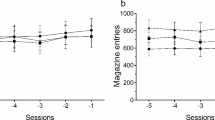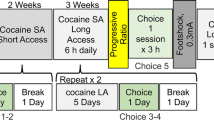Abstract
Rationale
The research of individual differences has opened new possibilities for better exploring the neurobiological basis of vulnerability to psychopathological disorders.
Objective
We extended this approach by using schedule-induced polydipsia (SIP).
Methods
Outbred male Wistar rats were characterized as either high (HD) or low (LD) drinker according to their behavior in SIP. Subsequently, their performance in the elevated plus maze (EPM) was studied for possible differences in anxiety-like behaviors. Finally, the effects of pentylenetetrazol (PTZ), diazepam, d-amphetamine, and cocaine on individual differences in SIP were investigated.
Results
HD rats acquired SIP faster and reached higher asymptotic levels than LD. Nose pokes, however, were greater in LD. In the EPM, there were no differences between HD and LD animals. Gabaergic drug effects on SIP did not differ between HD and LD rats. Compared to saline, PTZ reduced and diazepam increased water SIP drinking. On the other hand, amphetamine dose-dependently reduced SIP in HD, whereas the highest dose was required to reduce SIP in LD. HD rats also showed reductions in SIP drinking after cocaine administration. However, the effects of these drugs on nose pokes did not differ between HD and LD.
Conclusion
These data provide novel evidence that individual differences in SIP are not predictive of behavioral reactivity in animal models of anxiety and suggest an important role for the dopaminergic system in such individual differences. These findings point to SIP as a useful animal model for investigating the neurobiological basis of vulnerability to several psychopathologies in which the dopaminergic system is involved.







Similar content being viewed by others
References
Altemus M, Glowa JR, Galliven E, Leong YM, Murphy DL (1996) Effects of serotonergic agents on food-restriction-induced hyperactivity. Pharmacol Biochem Behav 53:123–131
Antelman SM, Caggiula AR, Black CA, Edwards DJ (1978) Stress reverse the anorexia induced by amphetamine and methylphenidate but not fenfluramine. Brain Res 143:580–585
Barnett S (1963) The rat: a study in behaviour. Aldine, Chicago
Brett LP, Levine S (1979) Schedule-induced polydipsia suppresses pituitary-adrenal activity in rats. J Comp Physiol Psychol 93:946–956
Brett LP, Levine S (1981) The pituitary-adrenal response to “minimized” schedule-induced drinking. Physiol Behav 26:153–158
Cardona D, Lopez-Grancha M, Lopez-Crespo G, Nieto-Escamez F, Sanchez-Santed F, Flores P (2006) Vulnerability of long-term neurotoxicity of chlorpyrifos: effect on schedule-induced polydipsia and a delay discounting task. Psychopharmacology (Berl) 189:47–57
Dantzer R, Mormede P (1981) Pituitary-adrenal consequences of adjunctive activities in pigs. Horm Behav 15:386–395
Dantzer R, Terlouw C, Mormede P, Le Moal M (1988a) Schedule-induced polydipsia experience decreases plasma corticosterone levels but increases plasma prolactin levels. Physiol Behav 43:275–279
Dantzer R, Terlouw C, Tazi A, Koolhaas JM, Bohus B, Koob GF, Le Moal M (1988b) The propensity for schedule-induced polydipsia is related to differences in conditioned avoidance behaviour and in defense reactions in a defeat test. Physiol Behav 43:269–273
DeCarolis NA, Myracle A, Erbach J, Glowa J, Flores P, Riley AL (2003) Strain-dependent differences in schedule-induced polydipsia: an assessment in Lewis and Fischer rats. Pharmacol Biochem Behav 74:755–763
Deroche V, Piazza PV, Le MM, Simon H (1993) Individual differences in the psychomotor effects of morphine are predicted by reactivity to novelty and influenced by corticosterone secretion. Brain Res 623:341–344
Erb SM, Parker LA (1994) Individual differences in novelty-induced activity do not predict strength of amphetamine-induced place conditioning. Pharmacol Biochem Behav 48:581–586
Falk J (1961) Production of polydipsia in normal rats by an intermittent food schedule. Science 133:195–196
Falk J (1971) The nature and determinants of adjunctive behavior. Physiol Behav 6:577–588
File SE, Zharkovsky A, Hitchcott PK (1992) Effects of nitrendipine, chlordiazepoxide, flumazenil and baclofen on the increased anxiety resulting from alcohol withdrawal. Prog Neuropsychopharmacol Biol Psychiatry 16:87–93
Flores P, Pellon R (1995) Rate-dependency hypothesis and the rate-decreasing effects of d-amphetamine on schedule-induced drinking. Behav Pharmacol 6:16–23
Flores P, Pellon R (1998) Effects of d-amphetamine, diazepam and buspirone on schedule-induced polydipsia suppressed by response-dependent and response-independent shock. Behav Pharmacol 9:127–135
Gilbert DB, Cooper SJ (1985) Analysis of dopamine D1 and D2 receptor involvement in d- and l-amphetamine-induced anorexia in rats. Brain Res Bull 15:385–389
Glick SD, Muller RU (1971) Paradoxical effects of low doses of d-amphetamine in rats. Psychopharmacologia 22:396–402
Gong W, Neill D, Justice JB Jr. (1996) Conditioned place preference and locomotor activation produced by injection of psychostimulants into ventral pallidum. Brain Res 707:64–74
Hooks MS, Jones GH, Smith AD, Neill DB, Justice JB Jr. (1991) Individual differences in locomotor activity and sensitization. Pharmacol Biochem Behav 38(2):467–470
Hooks MS, Jones GH, Neill DB, Justice JB Jr. (1992a) Individual differences in amphetamine sensitization: dose-dependent effects. Pharmacol Biochem Behav 41(1):203–210
Hooks MS, Jones GH, Liem BJ, Justice JB Jr. (1992b) Sensitization and individual differences to IP amphetamine, cocaine, or caffeine following repeated intracranial amphetamine infusions. Pharmacol Biochem Behav 43(3):815–823
Hooks MS, Jones GH, Juncos JL, Neill DB, Justice JB (1994) Individual differences in schedule-induced and conditioned behaviors. Behav Brain Res 60:199–209
Jones GH, Hooks MS, Juncos JL, Justice JB Jr. (1994) Effects of cocaine microinjections into the nucleus accumbens and medial prefrontal cortex on schedule-induced behaviour: comparison with systemic cocaine administration. Psychopharmacology (Berl) 115:375–382
Kabbaj M, Devine DP, Savage VR, Akil H (2000) Neurobiological correlates of individual differences in novelty-seeking behavior in the rat: differential expression of stress-related molecules. J Neurosci 20(18):6983–6988
Klebaur JE, Bevins RA, Segar TM, Bardo MT (2001) Individual differences in behavioral responses to novelty and amphetamine self-administration in male and female rats. Behav Pharmacol 12:267–275
Lopez-Grancha M, Lopez-Crespo G, Venero C, Cañadas F, Sanchez-Santed F, Flores P (2006) Differences in corticosterone level due to inter-food interval length: implications for schedule-induced polydipsia. Horm Behav 49:166–172
Martin JR, Ballard TM, Higgins GA (2002) Influence of the 5-HT2C receptor antagonist, SB-242084, in tests of anxiety. Pharmacol Biochem Behav 71(4):615–625
Mantsch JR, Ho A, Schlussman SD, Kreek MJ (2001) Predictable individual differences in the initiation of cocaine self-administration by rats under extended-access conditions are dose-dependent. Psychopharmacology (Berl) 157:31–39
McMillan DE (1979) Effects of d-amphetamine and caffeine on schedule-controlled and schedule-induced responding. J Exp Anal Behav 32(3):445–456
Mittleman G, Rosner AL, Schaub CL (1994) Polydipsia and dopamine: behavioral effects of dopamine D1 and D2 receptor agonists and antagonists. J Pharmacol Exp Ther 271(2):638–650
Mittleman G, Blaha CD, Phillips AG (1992) Pituitary-adrenal and dopaminergic modulation of schedule-induced polydipsia: behavioral and neurochemical evidence. Behav Neurosci 106:408–420
Mittleman G, Jones GH, Robbins TW (1988a) Effects of diazepam, FG 7142, and RO 15–1788 on schedule-induced polydipsia and the temporal control of behavior. Psychopharmacology (Berl) 94:103–109
Mittleman G, Jones GH, Robbins TW (1988b) The relationship between schedule-induced polydipsia and pituitary-adrenal activity: pharmacological and behavioral manipulations. Behav Brain Res 28:315–324
Mittleman G, Valenstein ES (1985) Individual differences in non-regulatory ingestive behavior and catecholamine systems. Brain Res 348:112–117
Mittleman G, Valenstein ES (1984) Ingestive behavior evoked by hypothalamic stimulation and schedule-induced polydipsia are related. Science 224:415–417
Myracle A, Lopez-Grancha M, Flores P, Glowa J, Riley AL (2005) Differential effects of morphine and LiCl on schedule-induced polydipsia. Pharmacol Biochem Behav 80:195–202
Pellon R, Blackman DE (1992) Effects of drugs on the temporal distribution of schedule-induced polydipsia in rats. Pharmacol Biochem Behav 43:689–695
Pellow S, File SE (1986) Anxiolytic and anxiogenic drug effects on exploratory activity in an elevated plus-maze: a novel test of anxiety in the rat. Pharmacol Biochem Behav 24:525–529
Pellow S, Chopin P, File SE, Briley M (1985) Validation of open:closed arm entries in an elevated plus-maze as a measure of anxiety in the rat. J Neurosci Methods 14:149–167
Piazza PV, Deminiere JM, Le Moal M, Simon H (1989) Factors that predict individual vulnerability to amphetamine self-administration. Science 245:1511–1513
Piazza PV, Mittleman G, Deminiere JM, Le Moal M, Simon H (1993) Relationship between schedule-induced polydipsia and amphetamine intravenous self-administration. Individual differences and role of experience. Behav Brain Res 55:185–193
Piazza PV, Deroche-Gamonet V, Rouge-Pont F, Le Moal M (2000) Vertical shifts in self-administration dose-response functions predict a drug-vulnerable phenotype predisposed to addiction. J Neurosci 20(11):4226–4232
Rodgers RJ, Johnson NJ (1995) Factor analysis of spatiotemporal and ethological measures in the murine elevated plus-maze test of anxiety. Pharmacol Biochem Behav 52:297–303
Sanchez-Amate MC, Flores P, Sanchez-Santed F (2001) Effects of chlorpyrifos in the plus-maze model of anxiety. Behav Pharmacol 12:285–292
Sanger DG, Blackman DE (1976) Effects of diazepam and ripazepam on two measures of adjunctive drinking in rats. Pharmacol Biochem Behav 5(2):139–142
Soulairac A (1969) The adrenergic and cholinergic control of food and water intake. Ann N Y Acad Sci 157:934–961
Staddon JE (1977) On Herrnstein’s equation and related forms. J Exp Anal Behav 28:163–170
Stohr T, Szuran T, Welzl H, Pliska V, Feldon J, Pryce CR (2000) Lewis/Fischer rat strain differences in endocrine and behavioural responses to environmental challenge. Pharmacol Biochem Behav 67:809–819
Stolerman IP, D’Mello GD (1978) Amphetamine-induced hypodipsia and its implications for conditioned taste aversion in rats. Pharmacol Biochem Behav 8:333–338
Suto N, Austin JD, Vezina P (2001) Locomotor response to novelty predicts a rat’s propensity to self-administer nicotine. Psychopharmacology (Berl) 158(2):175–180
Szechtman H, Sulis W, Eilam D (1998) Quinpirole induces compulsive checking behavior in rats: a potential animal model of obsessive-compulsive disorder (OCD). Behav Neurosci 112(6):1475–85
Tazi A, Dantzer R, Le MM (1988) Schedule-induced polydipsia experience decreases locomotor response to amphetamine. Brain Res 445:211–215
Tazi A, Dantzer R, Mormede P, Le MM (1986) Pituitary-adrenal correlates of schedule-induced polydipsia and wheel running in rats. Behav Brain Res 19:249–256
Wayner MJ (2002) Craving for alcohol in the rat: adjunctive behavior and the lateral hypothalamus. Pharmacol Biochem Behav 73:27–43
Williams JL, White JM (1984) The effects of amphetamine and scopolamine on adjunctive drinking and wheel-running in rats. Psychopharmacology (Berl) 82:360–367
Woods A, Smith C, Szewczak M, Dunn RW, Cornfeldt M, Corbett R (1993) Selective serotonin re-uptake inhibitors decrease schedule-induced polydipsia in rats: a potential model for obsessive compulsive disorder. Psychopharmacology (Berl) 112:195–198
Xigeng Z, Yonghui L, Xiaojing L, Lin X, Dongmei W, Jie L, Xiaoyan Y, Nan S (2004) Social crowding sensitizes high-responding rats to psychomotor-stimulant effects of morphine. Pharmacol Biochem Behav 79:213–218
Acknowledgments
This work was supported by the Spanish grants MEC BSO2002-04322-C02, (SEJ2006-15226-C02-01/PSIC) Spain.
Author information
Authors and Affiliations
Corresponding author
Additional information
M. López-Grancha and G. Lopez-Crespo contributed equally to the present work.
Rights and permissions
About this article
Cite this article
López-Grancha, M., Lopez-Crespo, G., Sanchez-Amate, M.C. et al. Individual differences in schedule-induced polydipsia and the role of gabaergic and dopaminergic systems. Psychopharmacology 197, 487–498 (2008). https://doi.org/10.1007/s00213-007-1059-6
Received:
Accepted:
Published:
Issue Date:
DOI: https://doi.org/10.1007/s00213-007-1059-6




